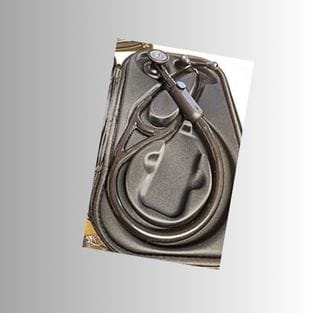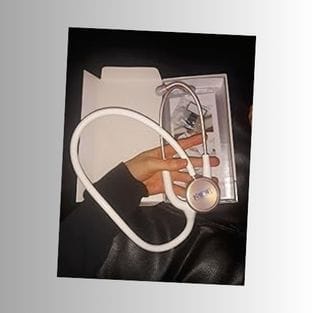When it comes to medical equipment, the stethoscope is as iconic as it gets.
A vital tool for any healthcare professional, it's the gateway to the body's internal symphony. But with a plethora of options available, how do you choose the best stethoscope for your needs?
This post will walk you through the nuances of finding the perfect match for your medical practice.
Key Takeaways:
- Understand the stethoscope, the different types of stethoscopes, and their specific uses.
- Learn about the features that matter most in a stethoscope for various healthcare settings.
- Discover the top stethoscope brands and models recommended by professionals.
What is a Stethoscope?
The stethoscope is an essential medical instrument designed for auscultation, which is the practice of listening to the internal sounds of a patient's body. It is commonly used to assess the sounds emanating from the heart or lungs.
The device is equipped with a small disc-shaped resonator that is placed directly on the patient's skin. This resonator is connected to earpieces via one or two tubes, allowing the healthcare professional to hear bodily sounds with enhanced clarity.
Stethoscopes are engineered to amplify low-volume sounds such as heartbeats, as well as intestinal, venous, and fetal sounds, for diagnostic purposes.
The instrument typically comprises a diaphragm that is positioned against the patient's skin, with the earpieces connected by flexible tubing to facilitate the transmission of sound to the listener's ears.
A Brief History of Auscultation
Regarded as a symbol of the medical profession, the stethoscope's origins date back to 1819.
It was in this year that the French physician René Laennec developed an early prototype, which consisted of a wooden tube and served to improve the auditory detection of sounds within the chest cavity.
Since its inception, the stethoscope has undergone numerous advancements to become the sophisticated tool it is today.

*From cardiology to pediatrics, the stethoscope remains an indispensable tool for diagnosing and monitoring patients.
The Anatomy of a Stethoscope
Understanding the components of a stethoscope is crucial in selecting the right one.
The ear tips, tubing, stem, and chest piece all play a role in sound transmission and comfort.
*High-quality materials and design can significantly enhance acoustic performance and durability, ensuring clear sounds and a long-lasting device.
Types of Stethoscopes
There are several types of stethoscopes tailored for specific medical tasks.
- The dual-head stethoscope, with its bell and diaphragm, is versatile for general use.
- A cardiology stethoscope, with its enhanced acoustics, is designed for detecting subtle heart sounds.
- Pediatric and neonatal stethoscopes have smaller chest pieces suitable for young patients.

Acoustic vs. Digital Stethoscopes
Acoustic stethoscopes rely on physical sound transmission, while digital stethoscopes amplify sounds electronically.
Digital models can offer recording capabilities and noise reduction, beneficial in noisy environments or for educational purposes.
However, they require batteries and can be more expensive than their acoustic counterparts.
Features to Consider
When choosing a stethoscope ...
- Consider the acoustic sensitivity, comfort, and build quality.
- Look for a model with a tunable diaphragm, comfortable ear tips, and a non-chill rim for patient comfort.
- The tubing length and flexibility can also affect your experience, as well as the stethoscope's weight.
The Importance of Durability
Durability is a key factor, especially for healthcare professionals who use their stethoscopes frequently.
Look for models with
- thick tubing,
- metal chest pieces, and
- tight seals.
**A good warranty can also be indicative of a stethoscope's longevity and the manufacturer's confidence in their product.
Top Stethoscope Brands
Several brands stand out in the stethoscope market.
- Littmann is renowned for its high-quality acoustic stethoscopes.
- Welch Allyn and Heine are also reputable brands that produce stethoscopes with excellent acoustic performance.

- ADC offers a range of durable and affordable options. Recommended Models for Different Specialties
Cardiologists may prefer the Littmann Cardiology IV for its superior acoustics, while general practitioners might opt for the Littmann Classic III for its versatility.

Pediatricians often choose stethoscopes with smaller chest pieces, like the ADC Adscope 618 Pediatric.
Caring for Your Stethoscope
Proper maintenance can extend the life of your stethoscope.
- Regular cleaning with alcohol wipes, avoiding extreme temperatures, and storing it properly can prevent damage.
- Inspecting the tubing and ear tips periodically for wear and tear is also essential to maintain optimal performance.
Making the Right Choice
Ultimately, the best stethoscope for your needs depends on your medical specialty, personal preferences, and budget.

Consider the features that are most important to you, and don't hesitate to invest in a quality instrument that will serve you well throughout your career.
Your Takeaway
Choosing the right stethoscope is a balance of understanding its history, knowing the different types available, and recognizing the features that are most important to you.
Whether you're a cardiologist in need of high-end acoustics or a general practitioner looking for versatility, there's a stethoscope designed to meet your needs.
*Remember to consider durability, brand reputation, and your specific specialty requirements when making your selection.
FAQ Section
Q: Can I use the same stethoscope for both adult and pediatric patients?
A: While some stethoscopes are designed to be versatile, it's often best to use a stethoscope with a chest piece that matches the patient's size for optimal sound quality.
Q: How often should I replace my stethoscope?
A: With proper care, a high-quality stethoscope can last for several years. Replace your stethoscope if you notice any deterioration in performance or physical damage that could affect its function.
Q: Are digital stethoscopes better than acoustic ones?
A: Digital stethoscopes offer features like sound amplification and recording, which can be beneficial in certain settings.
However, many healthcare professionals still prefer the reliability and simplicity of acoustic stethoscopes. The choice depends on your personal preference and needs.
Disclaimer.
When you purchase through links on our site, we may earn an affiliate commission (that's how we stay in business). FirstFewFinds may use affiliate links to products and services on retailer sites for which we can receive compensation if you click on those links or make purchases through them. We hope you find the list of our first few finds useful and helpful. Each product on our list has been carefully chosen by our writers and all opinions are our own. Check your choices and enjoy finding exactly what you need!








